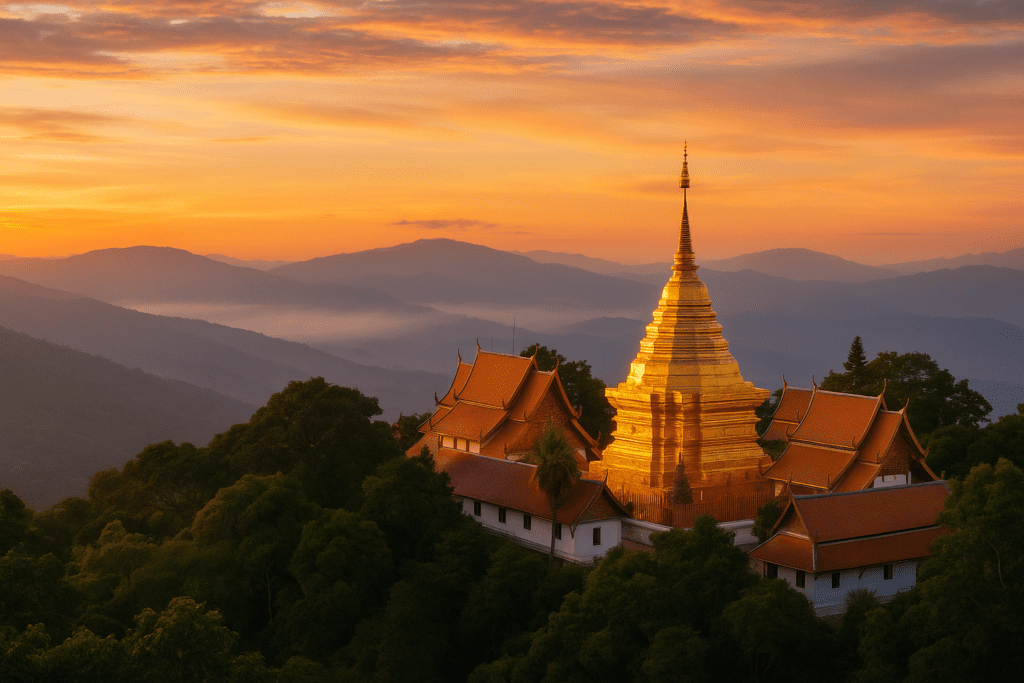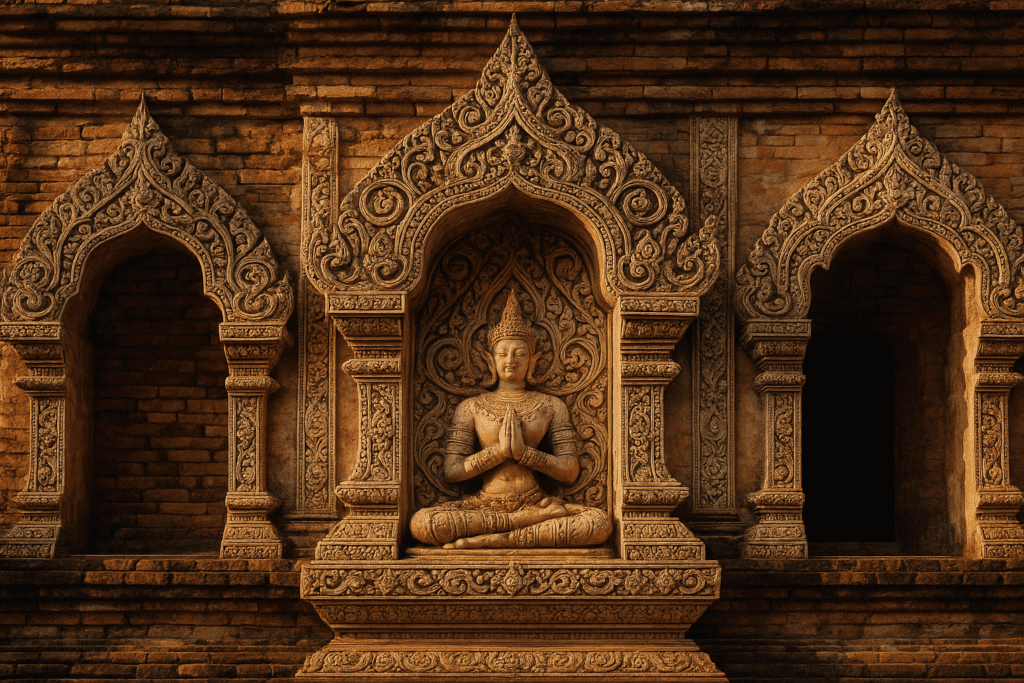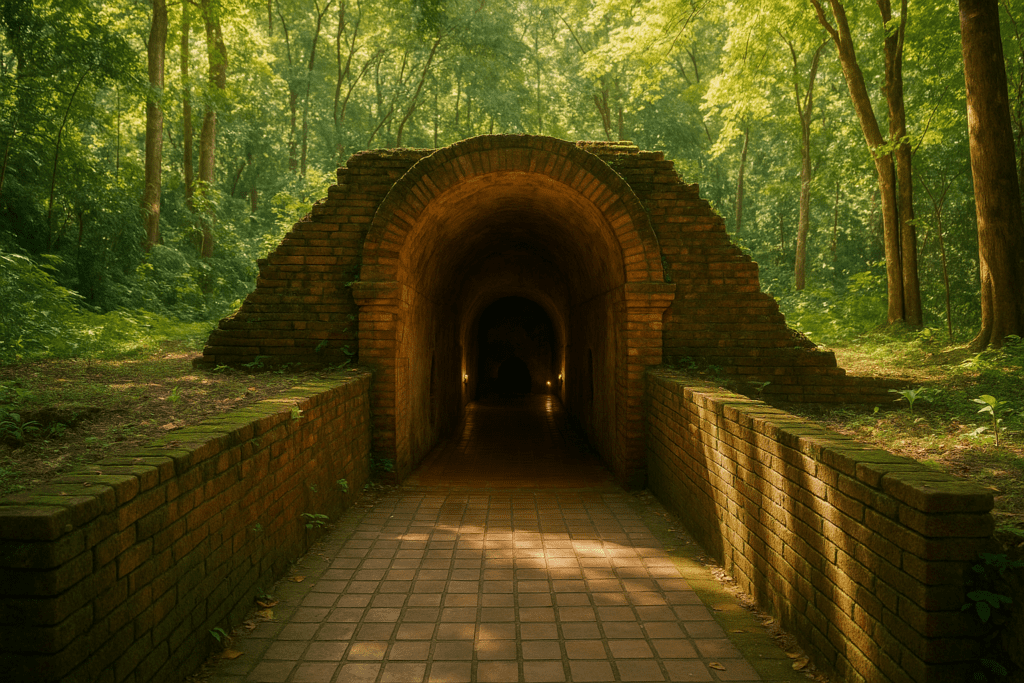Key Takeaways
- Chiang Mai houses the most spectacular collection of temples in northern Thailand, representing 8 centuries of Lanna Kingdom heritage
- Wat Phra That Doi Suthep offers the city’s most iconic temple experience with golden chedi and panoramic sunset views
- Wat Chedi Luang’s massive, partially-ruined structure once housed the sacred Emerald Buddha
- Proper temple etiquette requires covered shoulders and knees, removed shoes, and respectful behavior
- Early morning (8 AM) and late afternoon visits provide the best lighting and fewer crowds
- A motorbike offers maximum flexibility for temple hopping between city and mountain locations
Table of Contents

Picture yourself walking through ancient courtyards where golden stupas pierce the morning mist, the gentle sound of temple bells mingles with whispered prayers, and centuries-old incense creates an atmosphere of profound tranquility. This is Chiang Mai, where every corner reveals another architectural masterpiece steeped in spiritual significance.
This comprehensive guide will walk you through the absolute best temples in Chiang Mai, from the gleaming heights of Doi Suthep to the mysterious tunnels of Wat Umong. As the heart of the former Lanna Kingdom, Chiang Mai serves as the perfect gateway to explore the sacred temples northern Thailand is renowned for worldwide.
Whether you’re planning a single day of exploration or a week-long spiritual journey, this guide covers everything you need for an unforgettable temple hopping Chiang Mai adventure. For a full 5-day itinerary that includes these temple highlights and more, see our Ultimate Chiang Mai Travel Guide: Plan Your Perfect 5-Day Trip. We’ll reveal the most beautiful temples Chiang Mai has to offer, share insider tips for respectful visits, and uncover the fascinating stories behind each sacred site.

Chiang Mai: The Spiritual Heart of Lanna Culture
Since its founding in 1296 as the capital of the mighty Lanna Kingdom, Chiang Mai has served as the religious and cultural epicenter of northern Thailand. The city’s temples, known locally as “wats,” represent far more than simple places of worship—they’re living museums preserving eight centuries of artistic achievement, community gathering spaces, and the vibrant heartbeat of local festivals.
These sacred sites played crucial roles in legitimizing royal power and protecting the kingdom through spiritual means. Many temples were commissioned by Lanna kings seeking to enshrine precious Buddha relics, demonstrate their devotion to the dharma, and secure divine protection for their realms. This royal patronage explains why Chiang Mai boasts such an extraordinary concentration of architectural masterpieces.
The temples also served practical community functions, operating as schools, hospitals, and meeting halls. During major celebrations like Songkran (Thai New Year) and Loy Krathong (Festival of Lights), these sacred spaces transform into centers of joyous celebration, continuing traditions that stretch back centuries.
Today, this deep-rooted spiritual heritage makes Chiang Mai an essential destination for anyone seeking to understand Thai Buddhist culture and witness some of Asia’s most stunning religious architecture.
The Must-Visit Sanctuaries: A Tour of the Best Temples in Chiang Mai
Wat Phra That Doi Suthep – The Glistening Crown of the Mountain
No temple journey through Chiang Mai would be complete without ascending to Wat Phra That Doi Suthep, the city’s most sacred landmark and undoubtedly one of the best temples in Chiang Mai. Perched majestically on the slopes of Doi Suthep mountain, this golden sanctuary has watched over the city for more than six centuries.
The temple’s founding legend reads like a fairy tale with profound spiritual significance. In 1383, a sacred relic of the Buddha needed a new home. Monks placed it on the back of a mystical white elephant, which was then set free to wander wherever divine will directed. The elephant climbed the forested slopes of Doi Suthep, trumpeted three times to announce its arrival, and peacefully died—a clear sign that this elevated spot had been chosen by higher powers for the temple’s Learn more about this legendary founding at Joy Elephant Sanctuary.
The temple’s architectural marvels justify every effort required to reach them. The centerpiece golden chedi gleams brilliantly against the mountain backdrop, enshrining a piece of the Buddha’s shoulder bone within its sacred core. Intricate Lanna-style carvings cover every surface, while the famous 306-step staircase, flanked by ornate naga (serpent) balustrades, creates a pilgrimage experience that builds anticipation with every upward step.
From the temple’s terraces, visitors enjoy breathtaking panoramic views stretching across Chiang Mai city to the distant plains beyond. This elevated perspective offers a profound sense of the region’s geography and helps explain why this mountaintop location felt so spiritually significant to its ancient founders.
Practical visitors can choose between two approaches to reach the temple proper: climbing the 306 steps for a traditional pilgrimage experience or taking the convenient cable car for easier access. Come prepared with modest clothing covering shoulders and knees, comfortable walking shoes, and respect for the dozens of resident monkeys who call these grounds home. For the most magical experience, time your visit for late afternoon when golden hour light transforms the already-stunning views into an unforgettable sunset spectacle.
Wat Chedi Luang Chiang Mai – The Majestic Heart of the Old City
Standing like an ancient giant in the heart of Chiang Mai’s historic quarter, Wat Chedi Luang Chiang Mai commands attention with its massive, partially-ruined chedi that once served as the tallest structure in the entire Lanna Kingdom. This atmospheric temple ranks among the most beautiful temples Chiang Mai offers, combining archaeological wonder with active spiritual practice.
Construction of the enormous brick chedi began in the 14th century, eventually rising to house the kingdom’s most precious treasure: the legendary Emerald Buddha. This sacred statue, now enshrined in Bangkok’s Grand Palace, blessed Chiang Mai with its presence for several centuries, making Wat Chedi Luang a pilgrimage destination of national importance.
The temple’s dramatic appearance today results from a devastating 16th-century earthquake that toppled the chedi’s upper levels. Rather than diminishing its impact, this partial destruction creates an haunting beauty that speaks to the passage of time and the impermanence that lies at Buddhism’s philosophical heart. The remaining structure still towers impressively over the old city’s rooftlines, its weathered brick surfaces telling stories of six centuries of monsoons, celebrations, and quiet devotions.
Careful restoration work has stabilized the ancient structure while preserving its monumental character. The chedi’s tiered design showcases classic Lanna architectural principles, while detailed naga stairways guarded by elephant statues demonstrate the sophisticated artistry of medieval craftsmen. Modern visitors can explore the temple grounds, visit the active prayer halls, and observe daily rituals that connect today’s believers with their ancestors’ faith.
Plan your visit for early morning or late afternoon when softer light enhances the chedi’s dramatic shadows and fewer tourists allow for peaceful contemplation. Lucky visitors arriving during the annual Inthakhin Festival witness colorful ceremonies celebrating the city’s protective spirits in traditions dating back to the temple’s founding era.

Exploring More of the Most Beautiful Temples Chiang Mai Offers

Beyond the Icons: Three More Temples You Can’t Miss
Wat Phra Singh – The Temple of the Lion Buddha
Wat Phra Singh deserves recognition as one of Chiang Mai’s architectural jewels, famous for its stunning Viharn Lai Kham chapel that represents the pinnacle of Lanna artistic achievement. This classic wooden structure houses the revered Phra Phutta Sihing (Lion Buddha) image, a statue so sacred that kings once went to war over its possession.
The temple’s greatest treasures are its exquisite 14th-century murals depicting scenes from Buddhist folklore alongside glimpses of daily life in medieval Chiang Mai. These paintings provide invaluable insights into Lanna culture, showing everything from royal court ceremonies to common market scenes rendered in rich golds and earth tones that have survived centuries of tropical weather.
Don’t miss the intricate gold-and-ochre carvings decorating the chapel’s front facade—photography here captures some of the finest examples of northern Thai craftsmanship. Wat Phra Singh truly comes alive each April during Songkran celebrations, when the temple becomes the epicenter of Chiang Mai’s legendary water festival traditions.
Wat Suan Dok – The Royal Flower Garden Temple
Named for the flower gardens that once surrounded its grounds, Wat Suan Dok creates one of Chiang Mai’s most photogenic scenes with its collection of brilliant white-washed chedis containing the ashes of past Lanna royalty. These gleaming monuments arranged across manicured lawns create an almost ethereal atmosphere, especially when morning mist clings to their surfaces.
The temple’s massive open-sided prayer hall ranks among northern Thailand’s largest, while its connection to a respected Buddhist university adds intellectual depth to spiritual practice. International visitors particularly appreciate the famous “Monk Chat” program, offering rare opportunities for meaningful conversations with novice monks about Buddhist philosophy and monastic life.
Timing your visit for sunset transforms Wat Suan Dok into a photographer’s paradise, as golden hour light makes the white chedis glow like lanterns against the darkening sky. The peaceful atmosphere and spacious grounds make this an ideal spot for meditation or quiet reflection.
Wat Umong – The Forest Tunnel Temple
For visitors seeking a completely different temple experience, Wat Umong offers tranquil refuge in its forested setting away from the city’s bustle. This unique sanctuary takes its name from the 14th-century meditation tunnels (umong) that monks carved into a small hill, creating cool, cave-like spaces perfect for contemplation.
The temple’s peaceful atmosphere and active meditation programs attract serious practitioners alongside curious tourists. Ancient brick tunnels invite exploration, while the surrounding forest provides fresh air and bird songs that enhance the meditative environment. The grounds feature philosophical messages hanging from trees—the famous “talking trees” that offer wisdom in multiple languages.
A highlight for many visitors involves feeding the fish and turtles that inhabit the temple’s serene pond, surrounded by towering trees that filter sunlight into dancing patterns. This connection with nature, combined with the temple’s spiritual purpose, creates an experience that feels more like a forest retreat than a typical tourist destination. Combine visits to these off-the-beaten-path temples with some of Chiang Mai’s most scenic motorbike routes—explore our Top 10 Scenic Motorbike Routes Around Chiang Mai to plan your journey.
A Practical Guide to Your Temple Hopping Chiang Mai Adventure
Successfully navigating Chiang Mai’s temple treasures requires some advance planning, but the city’s compact size and excellent transport options make temple hopping Chiang Mai both convenient and rewarding. For detailed advice on planning your route and exploring Chiang Mai’s temples by motorbike, check out our Exploring Chiang Mai’s Temples by Motorbike guide.
For transportation around the Old City, colorful tuk-tuks and the iconic red songthaews (shared taxis) provide convenient, affordable options for short hops between temples. These traditional vehicles add authentic local flavor to your temple exploration while supporting traditional livelihoods.
For ultimate flexibility, especially when visiting hillside temples like Wat Phra That Doi Suthep or forest-based Wat Umong, renting a motorbike offers freedom to explore at your own pace and discover hidden gems along the way. You can arrange reliable bike rentals through services like Byklo.rent for a hassle-free booking experience before you even arrive in Chiang Mai.
One-Day Classic Temple Loop: Start early in the Old City with Wat Chedi Luang Chiang Mai and Wat Phra Singh, allowing 1-2 hours at each site for proper exploration. After lunch, make the journey up Doi Suthep mountain to reach Wat Phra That Doi Suthep in time for the spectacular sunset views over the city below.
Two-Day Immersive Route: Follow the one-day itinerary above, then dedicate your second day to the more contemplative experiences at Wat Suan Dok and Wat Umong. This relaxed pace allows time for meditation, monk chat programs, or simply absorbing the peaceful atmospheres these special places provide.
Proper dress and behavior show respect for these sacred spaces and Buddhist traditions. Cover your shoulders and knees completely—no tank tops, short shorts, or revealing clothing of any kind. Most major temples rent sarongs at their entrances for visitors who arrive unprepared. Remove shoes before entering any temple building, speak softly throughout the grounds, and avoid pointing your feet toward Buddha statues or monks. Always ask permission before photographing monks or ongoing religious ceremonies.
The best times for temple visits are early morning (around 8 AM) to beat crowds and midday heat, or late afternoon when softer light creates better photography conditions and cooler temperatures make walking more comfortable. Major Buddhist holidays like Visakha Bucha Day offer incredibly atmospheric experiences with special ceremonies and decorations, but expect much larger crowds during these spiritually significant periods.
Broadening Your Horizons: Sacred Temples of Northern Thailand
While Chiang Mai serves as the perfect introduction to northern Thai temple architecture and Buddhist culture, the region’s sacred temples northern Thailand is famous for extend far beyond the city limits. To discover more temple-centered excursions outside Chiang Mai, check out our Best Day Trips from Chiang Mai: 7 Tours to Doi Inthanon & Pai.
Ancient trade and pilgrimage routes linked Chiang Mai with other major religious centers, creating shared architectural styles and cultural traditions that transcended political boundaries. Important destinations like Wat Phra That Lampang Luang in nearby Lampang province showcase similar Lanna artistic traditions while maintaining their own unique characteristics and historical significance.
Closer to Chiang Mai, sites like Wat Phra That Doi Kham offer another mountaintop temple experience with fewer crowds and equally stunning valley views. These additional temples provide opportunities to observe how different communities interpreted shared Buddhist themes through their own artistic lenses.
The historical connections between these sacred temples northern Thailand treasures created a web of shared culture and faith that continues influencing the region today. Festivals, artistic motifs, and even construction techniques spread along these pilgrimage routes, creating the rich spiritual heritage that modern visitors can still experience throughout northern Thailand.
Conclusion
Chiang Mai rightfully deserves its reputation as one of the world’s premier destinations for temple exploration, offering an unmatched combination of historical significance, architectural beauty, and living spiritual tradition. From the golden splendor of Doi Suthep to the mysterious tunnels of Wat Umong, these sacred sites provide windows into eight centuries of continuous Buddhist practice and artistic achievement.
Your temple hopping Chiang Mai adventure awaits, promising encounters with some of the best temples in Chiang Mai and memories that will last a lifetime. Whether you’re drawn by spiritual curiosity, architectural appreciation, or cultural interest, these temple treasures offer something profound for every visitor willing to approach them with respect and open hearts.
Which temple has captured your imagination most? Are you excited to climb the 306 steps to Doi Suthep, explore the ancient tunnels at Wat Umong, or witness sunset lighting up the white chedis at Wat Suan Dok? Share your temple dreams and questions in the comments below!
FAQ Section
Q1: Which Chiang Mai temple is best for sunset?
Without a doubt, Wat Phra That Doi Suthep offers the most famous and spectacular sunset experience, with panoramic views of Chiang Mai city spread out below as the lights begin to twinkle in the gathering dusk. Read more about sunset viewing at Thai Unika Travel. For a beautiful alternative within the city itself, Wat Suan Dok creates magical scenes as golden hour light transforms its white chedis into glowing beacons.
Q2: How do I get to Wat Phra That Doi Suthep?
You can easily hire a songthaew (red truck taxi) from anywhere in Chiang Mai for the scenic mountain journey. For maximum freedom to explore at your own pace and enjoy the winding mountain roads, renting your own motorbike is ideal—check out Byklo.rent for convenient online reservations. Once you arrive at the temple base, choose between climbing the famous 306-step Naga staircase for a traditional pilgrimage experience or taking the quick cable car ride to the top.
Q3: Is there an entrance fee for the temples?
Most temples within Chiang Mai’s Old City welcome visitors free of charge, though donations for temple maintenance are always appreciated and support ongoing restoration work. Major tourist destinations like Wat Phra That Doi Suthep and Wat Chedi Luang Chiang Mai typically charge foreign visitors a modest entrance fee of 30-50 Thai Baht (approximately $1-1.50 USD), which directly supports the temples’ preservation efforts and facilities.
Frequently Asked Questions
What is the best time to visit temples in Chiang Mai?
The optimal times are early morning (around 8 AM) to avoid crowds and heat, or late afternoon for better photography lighting and cooler temperatures. Sunset visits to Wat Phra That Doi Suthep are particularly spectacular but expect larger crowds during this popular time.
How should I dress when visiting temples in Chiang Mai?
Cover your shoulders and knees completely – no tank tops, short shorts, or revealing clothing. Most major temples rent sarongs at entrances for unprepared visitors. Remove shoes before entering any temple building and dress respectfully as these are active religious sites.
Can I take photos inside the temples?
Photography rules vary by temple and specific areas within each temple. Generally, exterior photography is permitted, but always ask permission before photographing monks or ongoing religious ceremonies. Some inner sanctuaries may prohibit photography entirely – look for signs or ask temple staff.
How long should I plan for a temple hopping tour?
A comprehensive one-day tour covering Wat Chedi Luang, Wat Phra Singh, and Wat Phra That Doi Suthep requires 8-10 hours including travel time. For a more relaxed experience, spread visits across two days, dedicating the second day to Wat Suan Dok and Wat Umong.
What’s the best way to get around to different temples?
For Old City temples, tuk-tuks and red songthaews work well for short distances. For maximum flexibility, especially to reach hilltop temples like Doi Suthep or forest temples like Wat Umong, renting a motorbike provides the best freedom to explore at your own pace.


